
Written by Maia, President
Project One-Eleven is our non-toxic home renovation project. We’re taking an old row house that’s been serving as an office and converting it back into a residence where you’ll be able to come test mattresses and other Good Stuff.
Because we’re all about the Good Stuff, we’re using non-toxic and sustainable products, materials, and processes as much as possible. We’re blogging about the process to share the joys and challenges of taking a non-toxic approach to home renovation.
The Non-Toxic Kitchen Cabinet Conundrum
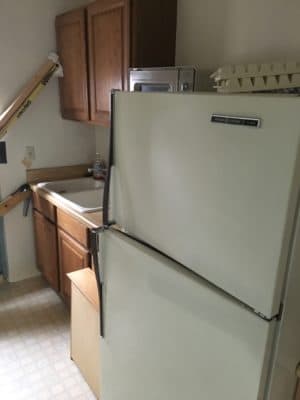
Before: This was the kitchen when we bought the property.
Next up for Project One-Eleven was installing the cabinetry (as we’ve noted, the existing “kitchen” (more like kitchenette) was on the third floor—and we turned that one into a bathroom).
Kitchen cabinets can be a major source of VOCs, thanks to the fact that most of them are made from engineered wood products like plywood, particleboard, and medium density fiberboard (MDF). Each of these materials is made using resins called urea formaldehyde, which is classified as a carcinogen. And the resins in engineered wood products can continue to release VOCs into your home for months or even years after manufacturing in a process called “off-gassing.”
Custom Kitchen Cabinets
So what can you use instead? Well, to get truly non-toxic kitchen cabinets, you’d hire a carpenter and have them custom built of solid wood that was finished with natural oils (like linseed) or beeswax. And ideally the glue used in your cabinetry would be PureBond, as it’s the least toxic.
As you can imagine, those cabinets would be pretty expensive. The other problem you’d encounter is that the kitchen gets hot and has a lot more moisture in the air than other parts of the home. So over time, the wood would warp as a result of prolonged exposure to moisture and heat—this is another reason most companies use engineered wood.
Our Goal for Non-Toxic Kitchen Cabinets
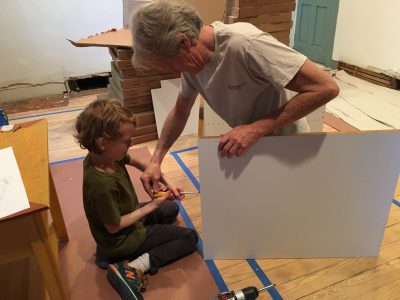
We did all the cabinet assembly ourselves, and my dad and husband did most of the hanging.
When it came to deciding on cabinets for Project One-Eleven, we wanted to find a good balance between several factors:
- We wanted the cabinets to have an aesthetic we liked.
- We also wanted our kitchen cabinets to be functional and durable.
- Then, of course, there was the toxicity and sustainability factor.
- Finally, we wanted to keep the cost down—it’s not hard to spend $30K on cabinets, and our budget for this project wasn’t going to allow that.
Here’s what we found:
Crystal Cabinets
If money were no object, I’d have gone with Crystal Cabinets for our new kitchen. Unlike some other brands, the Crystal boxes don’t have added formaldehyde and are GREENGUARD certified. The finishes are also GREENGAURD certified. In addition, Crystal Cabinets are great from an environmental standpoint, because you can get a FSC-certified version. However, these are the top of the line when it comes to non-toxic kitchen cabinets and are priced as such.
If you choose these cabinets, make sure you get one of their wood options, rather than a laminate or veneer. And note that they do use plywood boxes, which it seems all brands do. So you’d have to order custom-made solid wood boxes from a carpenter if you didn’t want any plywood at all in your kitchen cabinets. (Again, because Crystal boxes don’t contain formaldehyde, I wouldn’t worry about this.)
IKEA
On the other end of the cost spectrum are IKEA cabinets. At first, I was dead set against this brand because I know they’re made of particleboard and assumed they were toxic. After several phone calls, I learned that IKEA cabinets are CARB 2 compliant. That means they meet the California Air Resources Board’s (CARB) standards for formaldehyde emissions from engineered wood. You may also see CARB 2 compliant products labeled as “California 93120 compliant for formaldehyde” or “California Phase 2 compliant.”
While CARB 2 standards are pretty strict, GREENGUARD-compliant cabinetry (like Crystal) are still better. However, IKEA products aren’t as toxic as many other conventional brands, and all things considered, I felt like they were a reasonable option for this space. I still just didn’t love their look, though, so I thought about using IKEA cabinet boxes and adding higher-end doors (which has become a popular hack).
Semihandmade
I loved the idea of doors with a reclaimed look and we almost went with the ones from Semihandmade, a company devoted to making custom door fronts that fit on affordable IKEA boxes. The reason we ended up not getting these is because the door fronts alone were going to cost almost $10,000. That was without any sort of handles, and we still had to buy the IKEA boxes.
Moreover, using Semihandmade door fronts wouldn’t reduce the toxicity in the kitchen at all. When I first reached out to the company, they said: “While our products exceed the highest state emission standards in the country, we do still use formaldehydes in our MDF substrate as well as some solvent in our finishes. These are industry-standard practices.”
So in the end, Semihandmade doors filled the aesthetic and durability criteria, but not the cost or toxicity criteria.
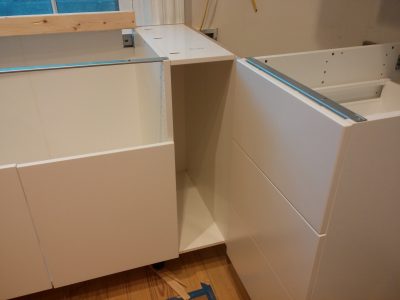
Final Answer: What Cabinets Did We Choose?
In the end, we went with plain white IKEA slab cabinets. We chose VEDDINGE because they were sealed around the edges. Theoretically, this means whichever toxins are used in the resin that holds together the particleboard’s interior will be trapped inside and release fewer VOCs than cabinets with unfinished edges (like the less expensive HAGGEBY).
All told, the IKEA cabinets and boxes ran us under $4,000.
Cabinet & Drawer Pulls
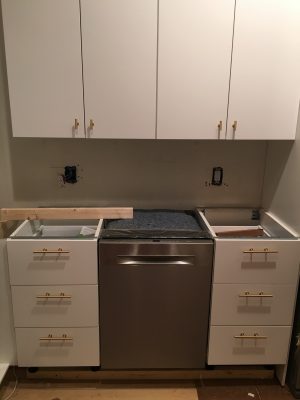 Now for the hardware. I really hated all of the IKEA options and wanted something more high end to make the cheaper cabinets look better. I thought about leather handles, but my dad pointed out how gross the leather would get in a kitchen. My husband fries food a lot (in avocado oil, ‘natch), so leather pulls would be disgusting and greasy within a week. Also, leather is actually really toxic.
Now for the hardware. I really hated all of the IKEA options and wanted something more high end to make the cheaper cabinets look better. I thought about leather handles, but my dad pointed out how gross the leather would get in a kitchen. My husband fries food a lot (in avocado oil, ‘natch), so leather pulls would be disgusting and greasy within a week. Also, leather is actually really toxic.
Here are the handles we ended up going with. Gold cabinet hardware is really trendy right now, so our choice is going to date the kitchen firmly in 2016. But we can always change the hardware when we get tired of it.
I’m hoping the IKEA cabinets aren’t emitting too much in the way of VOCs. We were really pleased that they had no smell when we took them out their boxes. But we’re also taking the following steps to reduce any VOCs from off-gassing from these cabinets, as well as other inevitable emissions:
- Placing Moso bags throughout the kitchen and all of Project One-Eleven.
- Airing out the kitchen by opening windows as much as possible.
- Investing in this Austin Air Filter.
- Testing the indoor air quality. I’m exploring ways to actually measure the contaminants in our indoor air, both in New York and Lancaster. I’ll report on this soon!

Stay sane,

P.S. If you’re wondering about the stone on top of the island, we will be blogging about that next!
P.P.S. This space is now open! Reserve your stay here and email Suzanne to make an appointment to come test mattresses or purchase select items from our store.
If you liked this post, sign up for our newsletter to be alerted when we publish new content like this!

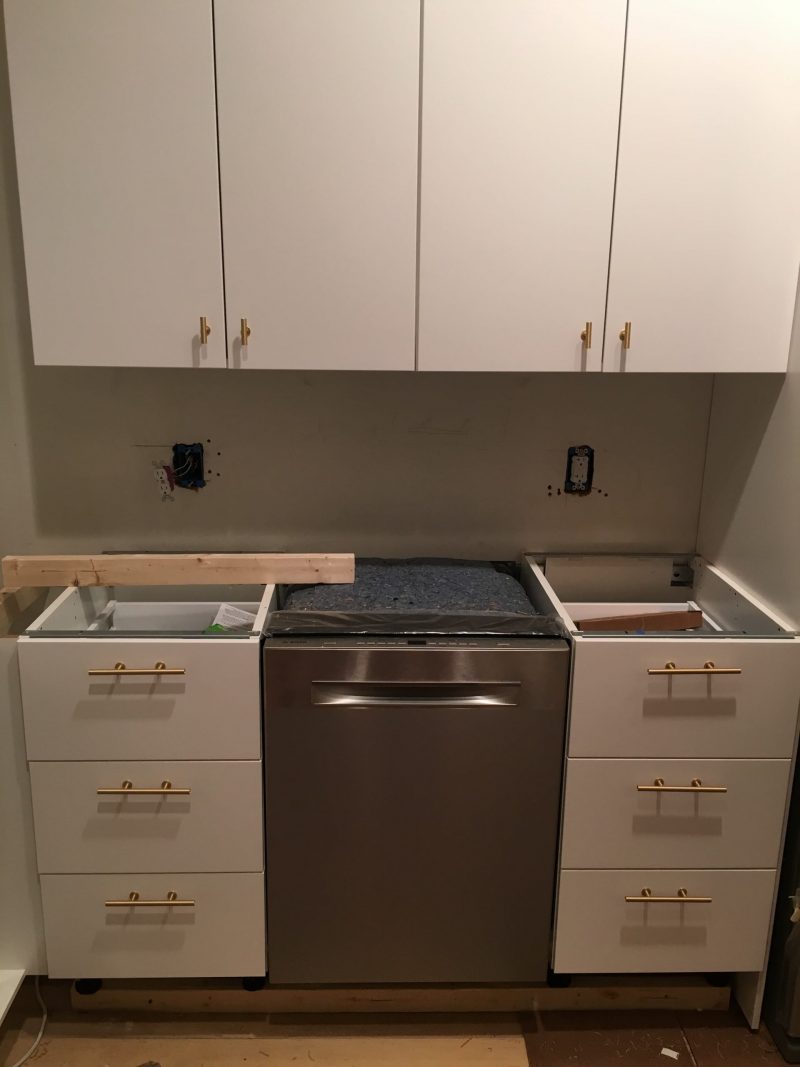

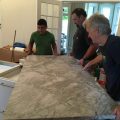


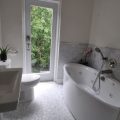


Sean Walsh says
Hello Maia. Great article and investigation into finding a better cabinet for the family. I owned a cabinet business for years and used to cut Chinese plywoods all day long that were not Carb2 compliant. I can’t imagine how much formaldehyde I have ingested ;o(… I started developing a few years ago and was searching high and low for a high quality healthier cabinet. I found a manufacturer from China that uses Low VOC finishes and CARB2 plywood. After putting them in our homes I fell in love with them, and I now supply these cabinets through the internet. Our website is http://www.walcraftcabinetry.com . I have three kids (and a pregnant wife) and am also very concerned with the nasty chemicals my kiddo’s are around. Just sharing this new venture if anyone is looking for a healthy affordable option. Take care.
Maia James says
Thank you, Sean!
Azale says
Thank you for the helpful article. Another reason not to use leather is that is unsafe for the cows.
Brenda says
There is a guy in North Central Arkansas that builds custom, formaldehyde free, solid wood cabinets with safe finishes. His name is Charles Bailey with Charles R. Bailey Cabinetmakers. Also you posted that you can use Linseed for your kitchen cabinetry. Linseed is very bad for someone who suffers with chemical sensitivities. Using a different finish would be wise.
Brenda says
The website for this company is http://www.charlesrbaileycabinetmakers.com
Vicki says
Hi Maia,
I have been searching for natural kitchen cupboard liner and not having much luck.
Cork ones are adhesive which I’m not keen on and the cotton canvas one I found has PVC non grip on one side, not keen on that at all. Do you know of any company that makes eco liners?
val says
I bought a new home 8 weeks ago, and it had a recently added IKEA kitchen that was beautiful. It was the reason I bought the place! within 2 weeks of moving into my new home I noticed a strong odor, I became deathly sick with nausea, headaches, fatigue, sore dry throat, burning eyes, insomnia, and more symptoms, and thought I was dying. It was so horrible. I had to move out. I called the EPA who told me right away that it probably was the IKEA cabinets. I then had my home tested with the health department, environmental division, and my IKEA cabinets were 1.70 !!!!! from formaldehyde. In Florida .75 is what is permitted. I have been to doctors and recently had a chemist, who is also an internal medicine physician tell me not to go back into my home until the cabinets are removed. This
is awful to experience. I cannot imagine how horrible this would be for children or babies to breath this toxic formaldehyde … or anyone for that matter!!!! I will be installing solid wood cabinets as soon as the IKEA cabinets are removed and the odor is out of my new home. BEWARE !!!!!!! I hope you don’t have to go through what I have just been through. I do not want my name published anywhere
Charles Bailey says
A story we here ALL THE TIME. You can’t put dangerous and toxic materials in your home and try to mask them or cover the edges and think it will be safe. Check us out. http://www.charlesrbaileycabinetmakers.com or http://www.healthycabinetmakers.com. We are truly chemical free and were that way before California created CARB and their compliant standards. Built by a cabinetmaker who is chemical sensitive.
heather says
So, what was the result of your VOC testing? Did you ever get it done?
Susan says
I am also wondering about the results of your VOC testing. I bought IKEA Kitchen cabinets for our office and the smell is awful and I have felt sick ever since. The cabinets are have been off-gassing for 3 months and don’t seem to be stopping anytime soon. I can only guess the test results weren’t good and that is why they aren’t posted.
Kelly Bailey says
Cabinetry with formaldehyde can outgass for up to 30 years.
Mary says
Hello, I like this company: https://woodcabinets4less.com/?gclid=CjwKCAiAws7uBRAkEiwAMlbZjrynW41TxQlJH1u65tvgjJcq2Ubz1vIBQvYjbbKaUUsUTVMyUvMgaRoCjCgQAvD_BwE.
The company name is woodcabinets4less. Their cabinets are CARB2 compliant and EPA TSCA TITLE VI compliant. Most of their cabinets are made in the USA, they have all wood boxes and most cabinet doors are also all wood. I am not sure if their cabinets would work for people with high sensitivity to odors but they seem to be a good company.
Blessings.
Diane says
Thanks for the input on wood cabinets 4 less. They look to be a more affordable option. What was the quality like in your cabinets, any paint odors did you notice?
jennifer says
Also looking into Ikea. Some of the cabinets contain melamine/foil. How do you feel about those as options? I noticed veddinge didn’t have either of those.
Anonymous says
Anonymous says
Patricia Newell says
When researching non-toxic cabinetry options you are not limited to wood. Wood or its derivatives almost always involves some kind of adhesive (formaldehyde) or VOC at some point in manufacturing or installation. Check out all metal cabinetry as an option. And no, it’s not cold or look industrial! This system is 100% non-toxic, apt for those who are chemically sensitive and also meets all WELL criteria for indoor air quality. http://www.imdcabinets.com
Sasha says
I purchased Sektion kitchen in September 21’. Convenience was appealing, but during install sektion frames emitted terrible odor. Later I experienced nausea and headache.s. From reviews I’ve read, it seams to affect some individuals. If anyone is considering ikea cabinets, order a base and door first. Not the entire kitchen. I ordered lowers first but ultimately decided to return. Decided on custom/bamboo doors. Price was significantly more due to rising cost of lumber, but my health was more important.